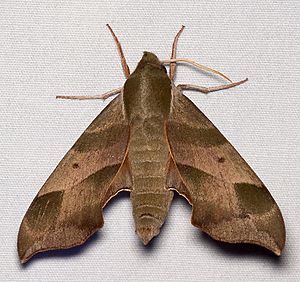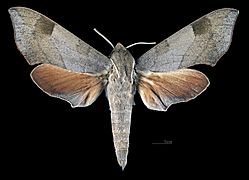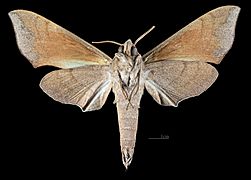Virginia creeper sphinx facts for kids
Quick facts for kids Darapsa myron |
|
|---|---|
 |
|
| Darapsa myron, adult | |
| Scientific classification | |
| Synonyms | |
|
The Virginia creeper sphinx is a type of moth. Its scientific name is Darapsa myron. You can find these moths in central and eastern North America. They belong to a family of moths called Sphingidae.
Contents
Where the Virginia Creeper Sphinx Lives
This moth lives in many places. In Canada, you can find it in southern Ontario and Quebec.
In the United States, it lives from Maine down to southern Florida. It also spreads west to states like North Dakota, Nebraska, New Mexico, and Texas. You might even spot them in Mexico!
What the Virginia Creeper Sphinx Looks Like
The Virginia creeper sphinx moth has a unique look. Its wings have special patterns. These patterns help it blend in with its surroundings.
Life Cycle and Habits
These moths have a busy life! They can have two or three groups of babies (called broods) each year. Their young, called larvae or caterpillars, can grow up very quickly. Sometimes, it takes only three weeks!
Caterpillar Life
The caterpillars are quite sneaky. They hide on the middle veins of the leaves they eat. They mostly feed at night when it's dark.
Adult Moth Behavior
Adult moths come out in the afternoon. Female moths start looking for mates after the sun goes down. In the spring, adult moths often drink nectar from flowers. They also like to sip juices from rotting fruit.
If you live where these moths are common, you might see them near lights. They also like sugary baits. They are most active between sunset and midnight.
Telling Males and Females Apart
It's easy to tell the difference between male and female moths. Female moths have rounder bodies. Male moths have a spade-shaped end to their bodies.
Reproduction
Mating for these moths happens quite fast. Female moths lay up to 150 small eggs. The eggs start out green. But after two days, they turn yellow. This color change means they are fertile. The eggs hatch in about six days.
When caterpillars are fully grown, they turn a purplish-brown color. Then, they spin a loose, thin cocoon among the leaves. The pupae (the stage after caterpillar) will either hatch into an adult moth in about 24 days or wait. If they wait, they will hatch in late May.
What They Eat
The caterpillars of the Virginia creeper sphinx moth love to eat certain plants. They are known to feed on Virginia creeper plants. They also eat plants from the Ampelopsis family and grape vines.
Types of Virginia Creeper Sphinx Moths
There are a few different types, or subspecies, of this moth.
- Darapsa myron myron
- Darapsa myron mexicana (Gehlen, 1933) (found in Mexico)





